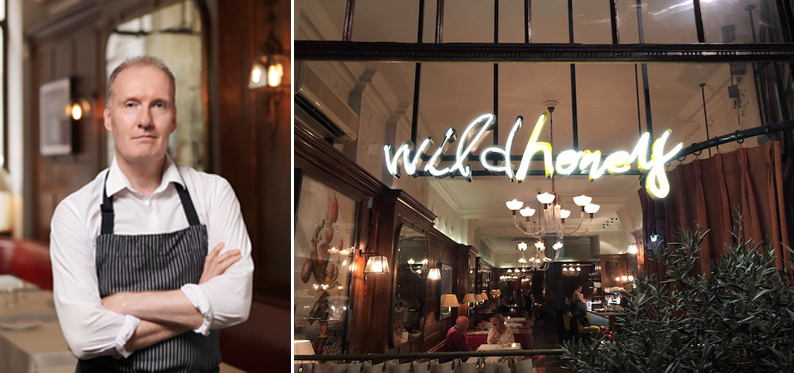
Anthony Demetre’s Wild Honey, in the heart of Mayfair, celebrated its tenth anniversary in 2017. This is no mean feat in the highly competitive world of fine dining, where casualties greatly outnumber successes. Yet Anthony Demetre is a true veteran – in the best sense of the word – of the London gastronomic scene. It is a rare pleasure to chat with a chef whose experience with two of the greats of the last three decades – Gary Rhodes (at The Castle, Taunton), and Bruno Loubet (at The Four Seasons and Bistrot Bruno) – existed alongside a glittering world that also featured Nico Ladenis, Marco Pierre White and Gordon Ramsay, to name but three.
Along with many fans of “bistronomy” (although not familiar with the term at the time), I was a regular visitor to Bistrot Bruno in Frith Street and later at L’Odeon overlooking Regent Street, where skilful, inventive cooking and relaxed, efficient service could be had in simple yet comfortable surroundings at attractive prices. These two restaurants, where Anthony honed his skills, were always packed, so booking was essential.
Awarded Michelin stars at Putney Bridge (where he was chef/director) and his first two restaurants – in partnership with Will Smith – Arbutus and Wild Honey, all in their first year of opening, Anthony’s culinary reputation was assured.
His cooking style is rooted in the classics, eschewing the latest fashions and fads. Use of the hob, grill and oven, without the use of sous vide, are the preferred methods. This needs precise timing in cooking and resting, essentials lost in less worthy kitchens. Flavours are bold and combinations are harmonious, showing balance in tastes and textures. Plates rarely exceed four ingredients, allowing each one to shine. Vegetables serve not as a mere garnish but an essential components in the success of each dish. Presentation is clean and attractive without being contrived. Although perhaps a little less adventurous and experimental and using more luxurious ingredients than Arbutus, where the mackerel and squid burger was a signature dish, the menu at Wild Honey still delivers in terms of finely executed contemporary cooking.
The winter a la carte menu features a winning formula of seven starters from £8 to £16; seven mains, £17 to £29, with rib of beef at £49.50 for two; cheese at £14; and five desserts at £9, with tarte tatin serving two, three or four at £20. Given the superb quality of the seasonal ingredients and the sharply honed skill in cooking at this level, not to mention the Mayfair location, these prices are eminently fair, offering perhaps the best value in this part of the West End. This applies even more to the £35 three course set lunch and early supper (6.pm to 7.pm) menu, which includes some dishes from the carte.
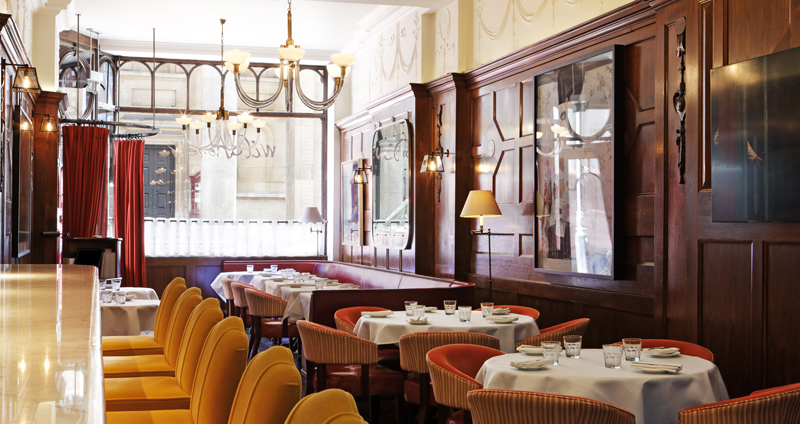
Revisiting Wild Honey after a few years’ absence, I found the renovations – completed in 2012 – had improved the restaurant considerably. Brighter chandelier lighting, the removal of booths, and the relocation of the mirrored bar to the centre of the restaurant gives a more spacious feel to the long, narrow oak panelled room. More comfortable too are the rounded sofa tables replacing the banquette seating. Colourful photographic artwork, curated by Maxine Davidson remains as before, adding a contemporary note to the club-like atmosphere.
Not that service is haughty or over formal. Overseen by David Durack, the relaxed formality is in keeping with modern trends, putting guests at their ease. It is attentive and knowledgeable without being intrusive.
A mid-week dinner for three in February began with an Apple Negroni, a variation on a classic cocktail, the red apple, Campari and vermouth complementing the botanicals of the in house distilled gin. This is a new, exciting addition to Anthony’s repertoire.
In addition to the extensive, 100 bin wine list, which includes organic and biodynamic selections, it was pleasing to see on the daily menu two wines by “Coravin.” This is, after all, Mayfair, where budgets can stretch!
A starter of Cornish mussels saw the creaminess of the flesh balanced by the inspired additon fo blood orange, the sweet acidity working well with the plump bivalve. Sea purslane acted as a seasoning, giving a measured degree of saltiness.
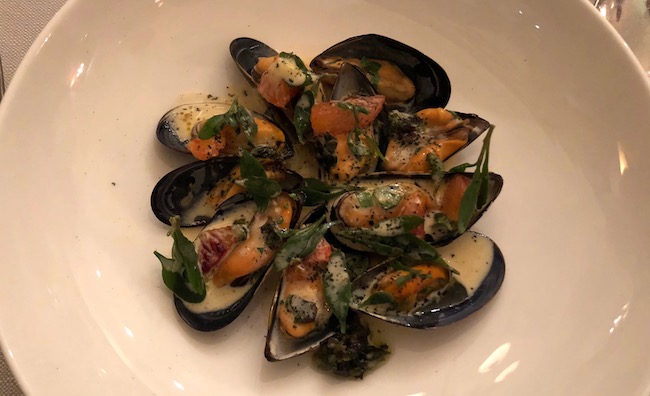
Grilled quail – not the most flavoursome of game birds – was lifted by lacquered coating of honey and sweet spices – amchor, sechuan pepper, cardamom, cinnamon, and cumin. Kumquat puree gave a counterpoint with its sweet bitterness whilst winter vegetables provided the necessary textural contrast.
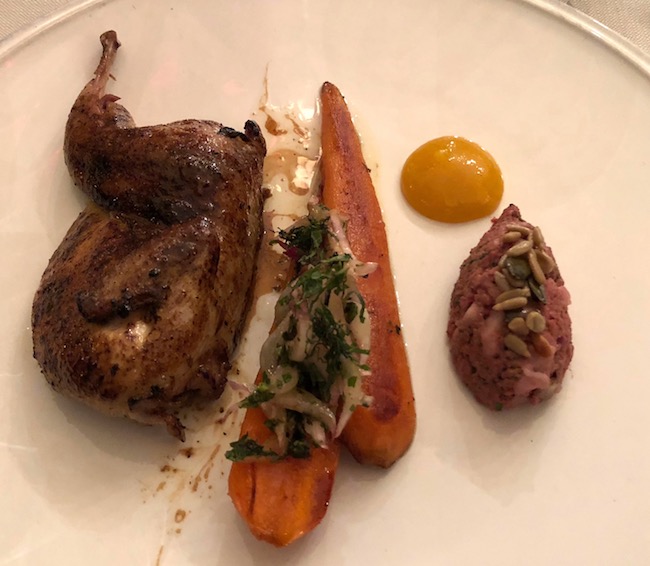
Grilled Galician octopus was precisely timed, the gentle smokiness not overpowering its mild flavour and tender texture. Paired with a finely judged creamy squid ink polenta, adding flavour as well as colour, the dish was dressed with a salsa verde, the grassy piquancy of which enlivened the dish. If only there was more of this!
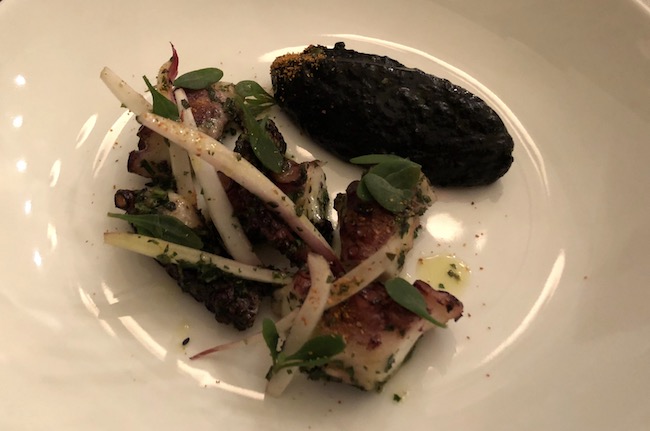
The fourth starter, a smooth Guinea fowl and foie gras boudin blanc – a rich but light pairing – was poached and browned in the pan to perfection. Celeriac tagliatelle with its subtle celery like flavour and nutty overtones added texture whilst pickled quince gave a tartness that worked well with the other components.
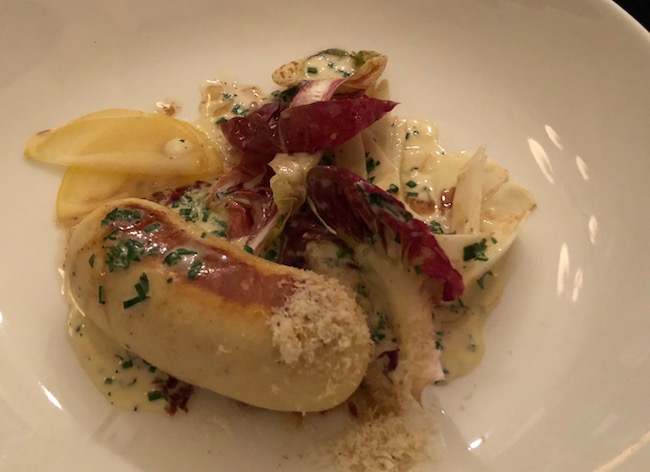
A main course of Lancashire (Goosnargh) duck was accurately timed and well rested, doing full justice to the deep flavour and dense texture of the thick breast. An accompanying pastilla of the leg meat resting on a bowl of herbed grains,was lightly spiced and well-seasoned. Silky caramelised cauliflower puree – possibly the best way to treat this most uninteresting of vegetables – young parsnips, and red cabbage all complemented the duck well.
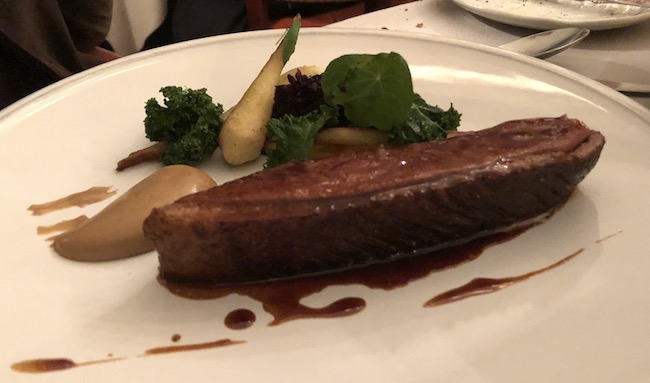
A second main featured rabbit, that notoriously difficult protein to cook. The saddle and farce, wrapped in pancetta, seared in the pan and finished in the oven, retained its moisture and delicate flavour. Equally impressive was an accompanying cottage pie featuring the slow cooked shoulder meat topped with a potato puree of exquisite smoothness and creaminess. Caramelised endive and chestnut mushrooms completed this tour de force of game cookery.
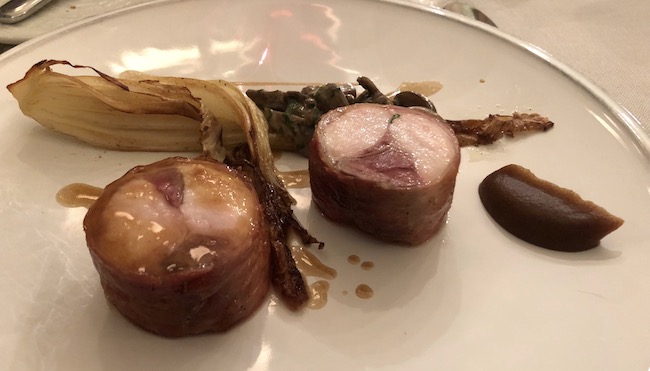
The same skill was shown in the third main course of roast loin of Dartmoor venison. Cooked to a medium rare to showcase its mild gaminess, it was paired with sweet potato, beetroot and onion, all of which emphasised the essential earthy flavours of the dish.
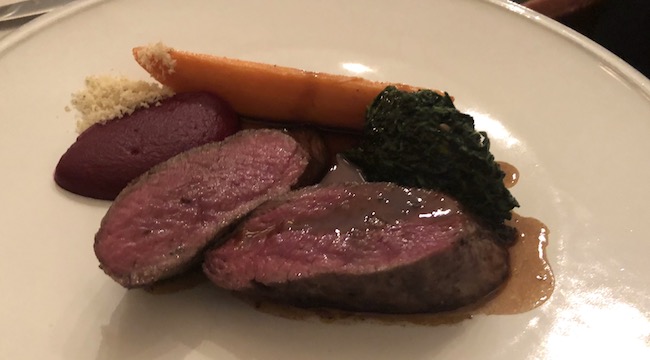
For dessert, we all opted for the irresistible tarte tatin. The not too sweet dark amber caramel enrobed generous wedges of soft apple and fine pastry in this classic, well executed dessert.
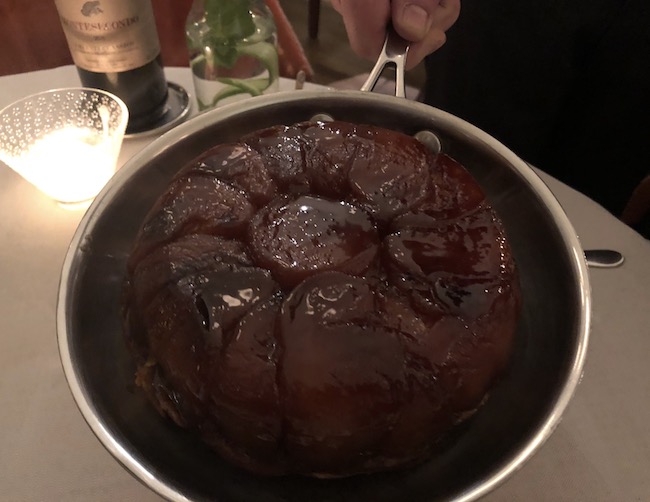
Good coffee and signature cannele completed a memorable meal, one enhanced by the seamless service and the lively buzz of contented diners in a busy restaurant.
Wild Honey is a class act, but nothing less would be expected of a chef whose wide experience and refined skills transcend the more ephemeral developments of the restaurant scene. No doubt Fine Dining Guide will return to sample the remaining abindance of riches on the menu.



